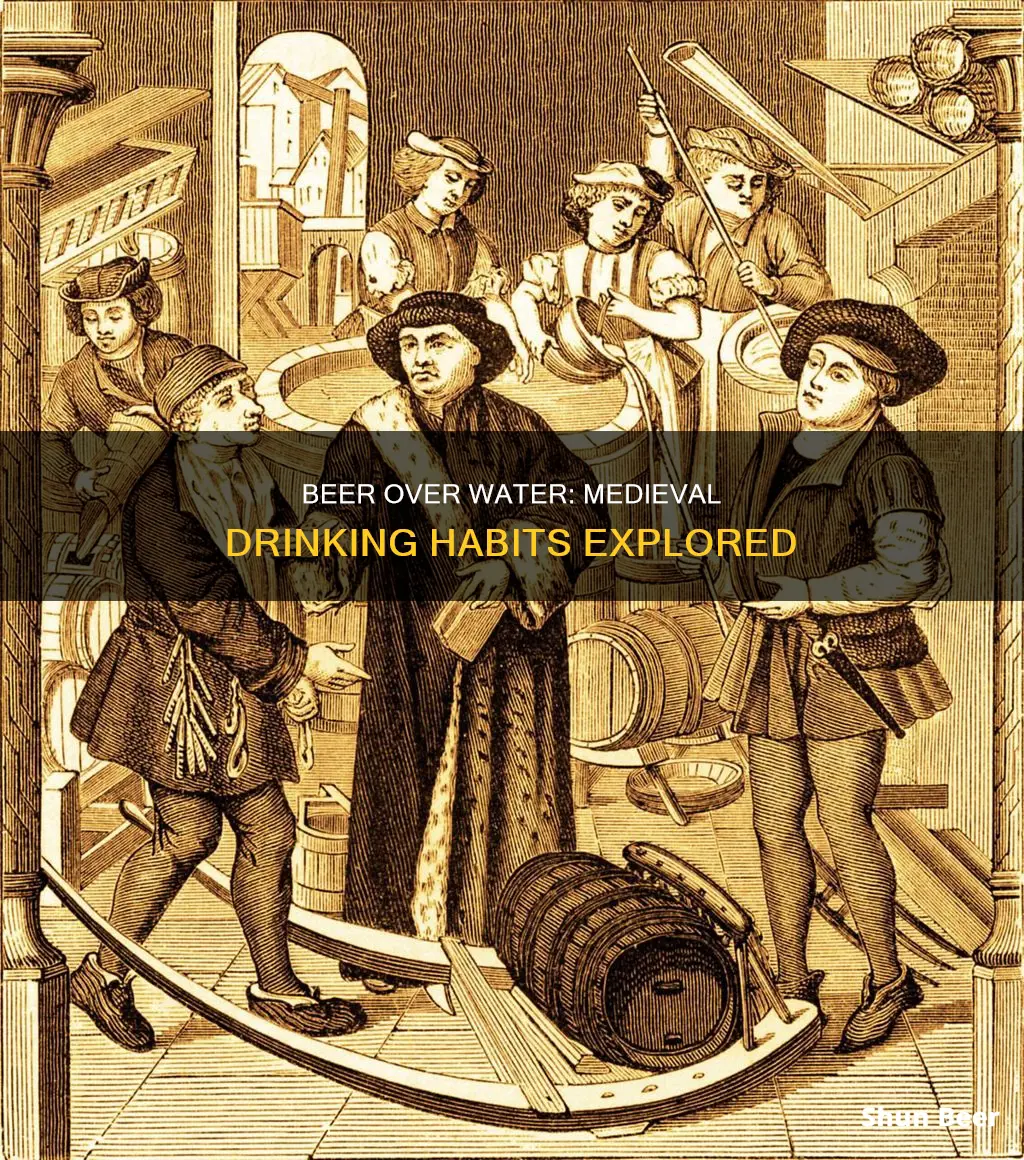
It is a common misconception that people in the Middle Ages drank beer instead of water. This myth is often attributed to the belief that water was unsafe to drink during this period due to a lack of hygiene and adequate sewage disposal systems. However, historical records indicate that medieval people consumed water regularly and that it was easily accessible and free. While beer was widely consumed, it was considered more of a nutritious snack than a substitute for water.
| Characteristics | Values |
|---|---|
| Was water available and safe to drink? | Yes, water was available and safe to drink. |
| Was beer a replacement for water? | No, beer was not a replacement for water. |
| Was beer commonly consumed? | Yes, beer was commonly consumed, but it was more expensive than water. |
| Why was beer consumed? | Beer was viewed as a nutritious alternative to water and was calorie-laden. |
| Was water free? | Yes, water was free. |
What You'll Learn

Water was free and accessible in the Middle Ages
In the 9th century, Abbot of Ferrieres Lupus Servatus wrote, "Let us make use of a healthy, natural drink which will sometimes be of benefit to both body and soul – if it is drawn not from a muddy cistern but from a clear well or the current of a transparent brook."
Water was free and accessible from wells and fresh streams, which were the centerpieces of villages. In larger towns, there were even infrastructures to supply water to citizens. In 1236, construction began on a system of pipes in London, designed to move water from a fresh spring to a pumping house that would make fresh water available at cisterns throughout the city.
Medieval people did not drink water that looked or smelled bad, and tradesmen who used water faced hefty fines if they polluted the town's drinking supply. Medieval cities spent large amounts of money on creating and maintaining water supply sources. For example, in the 13th century, the city of London constructed 'The Conduit'. Using a system of lead pipes, it brought fresh water from a spring outside the city walls into the middle of London, where people could freely access it.
In medieval villages and rural homes, the toilet was a few steps away in the forest. In larger towns, toilets were built with runoff trenches to keep human waste away from drinking water sources. Some had 'gutters' that pushed off effluent into the surrounding landscape. Where there were faster-running rivers, towns could dump waste into the waterways without affecting drinking water sources.
The sources of potable water were generally wells, sometimes artesian, sometimes spring-fed, and often in the center of the village as a common resource. Large villages, cities, and some castles would have cisterns to collect water, either through surviving aqueducts, from springs, or from rainwater.
People in the Middle Ages were aware that not all water was safe to drink. In addition to polluted water, which was largely confined to urban areas, they knew to avoid obtaining water from marshy areas or places of standing water. However, if they knew the water was coming from a good source, they would not be afraid to drink from it.
Antibiotics and Alcohol: One Beer, Any Harm?
You may want to see also

Beer was a nutritious snack, not a hydration method
It is a common misconception that people in the Middle Ages drank beer instead of water. While water was indeed free and readily available from natural sources, beer was also a popular drink. However, it was viewed more as a nutritious snack than a method of hydration.
The beer consumed during this period was quite different from the beer we know today. It was weakly brewed from barley and had a low alcohol content, with an ABV of around three percent. As such, people did not drink beer to get drunk but rather as a source of carbohydrates and calories. For peasants performing hard labour all day, beer would have been a more nutritious and energising choice than water.
Beer was also seen as safer than water, which could be contaminated with bacteria and diseases such as cholera. However, medieval people were not ignorant of water purity. They understood the importance of clean water sources and took measures to prevent pollution from human or livestock waste. Even in densely populated areas like London, there was infrastructure in place to supply citizens with clean water.
While beer was consumed regularly, it was also more expensive than water due to taxes and transportation fees. Therefore, it is unlikely that medieval people drank beer exclusively. Instead, they likely drank a variety of beverages, including water, beer, wine, and other fermented drinks, depending on their preferences, needs, and economic status.
In conclusion, while beer was certainly a part of daily life in the Middle Ages, it is important to recognise that it served a different purpose than it does today. It was a nutritious snack that provided energy and hydration, similar to how one might view sports drinks or energy drinks in modern times.
Beer Diet: Does It Work?
You may want to see also

Medieval beer was weaker than today's beer
It is a common misconception that people in the Middle Ages drank beer instead of water. In reality, medieval people consumed water, and it was free and clean. Medieval towns even had infrastructures to supply water to citizens. For example, in 1236, construction began on a system of pipes in London to make fresh water available throughout the city.
However, beer was also a popular beverage during this period. Medieval beer was weakly brewed from barley, and it provided calories and energy for workers and farmers. It was also seen as a nutritious alternative to water.
The alcohol content of medieval beer was typically low, and it was barely intoxicating. Small beers, with an alcohol content of around 1-3% ABV, were common. These weaker beers were often consumed as a calorie-rich energy drink by laborers. However, stronger beers were also available, with some having an alcohol content as high as 10% ABV or more.
The process of making beer involved mashing or steeping grain in hot water, which helped kill off pathogens and purify the water. This may have contributed to the perception that beer was safer to drink than water. However, people in the Middle Ages were also concerned about water quality and took measures to protect their water sources from pollution and poisoning.
Beer on Metro-North: What's the Rule?
You may want to see also

Water was plentiful and common
Water was also free and clean. Whether from a well or fresh stream, it was the centerpiece of villages. In larger towns, there were even infrastructures to supply water to citizens. In 1236, construction of a system of pipes began in London. It was designed to move water from a fresh spring to a pumping house that would, in turn, make fresh water available at cisterns throughout the city. Medieval people did not drink water that looked or smelled bad, and tradesmen who used water, such as tanning, faced hefty fines if they polluted the town's drinking supply.
Water was also mixed with wine or sweeteners like honey, and a 14th-century monk once listed water as a beverage preferred over beer.
Drinking Beer in Marrakech: What's the Deal?
You may want to see also

Beer was viewed as more nutritious than water
Beer was viewed as a more nutritious alternative to water in the Middle Ages. Although it was weakly brewed from barley, beer was a calorie-laden beverage that was ideal for workers and farmers who were thirsty and in need of energy.
The beer of Medieval Europe was weaker than that of today, with an ABV of around three percent. People didn’t drink it to get drunk but as a source of carbs and calories. If you were a peasant performing hard labor all day, beer would have been a more nutritious and energy-providing choice than water.
There were also other drinks that people made, which featured heating, fermentation, or souring, making them safer than water. These included juniper berry beer, kvass (from flour or kitchen leftovers or sometimes both), fermented birch sap, a drink from the soured mash, and a range of sour milk-based drinks.
In addition, beer was commonly used to pay taxes and tithes in the Middle Ages. It was also more expensive than water, as it had to be purchased, and there were often taxes and transportation fees involved.
Beer and Aleve: Safe Mix or Health Risk?
You may want to see also
Frequently asked questions
No, this is a common misconception. Medieval people did drink beer, but it was more of a nutritious snack than a method of hydration. Water was free and readily available from natural sources such as rivers and streams, and communities generally kept their water sources clean.
Beer was seen as a nutritious alternative to water, providing carbs and calories. It was also enjoyed as a social drink, just as it is today.
Yes, beer was more expensive than water as it had to be purchased, and there were often taxes and transportation fees involved.
Water quality was mixed. While natural water sources were relatively clean, waterborne diseases were common, and cholera was a major killer. However, medieval people were not stupid—they avoided water that looked or smelled bad, and there were fines for polluting water sources.







